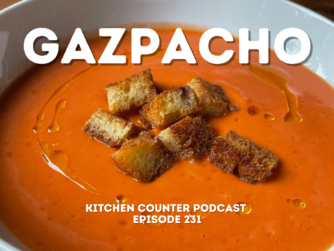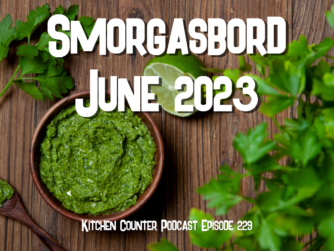Download the episode MP3 (right click to save)
Peeling Back the Layers
Imagine an ingredient that has been around as long as civilization itself, and is used heavily in almost every culture and cuisine in the world. The builders of the pyramids of Egypt ate it for nourishment. At other times in world history, it was considered so valuable that people would pay their rent with it, or give it as gifts. Ancient Greek athletes would eat it in the belief that it enhanced their athletic prowess. Roman gladiators would rub it all over their bodies to firm up their muscles. Doctors prescribed it to alleviate snakebites, coughs, and headaches.*
In modern cooking, it helps to give many of your favorite dishes a depth of flavor that can’t really be achieved by substituting any other ingredient. Behold, the mighty onion!
Wait, I’m sorry. Did you think I was going to say bacon? Or chile peppers, quinoa, kale, or goji berries, or any number of other fad food items that have gained and lost popularity over the years? Interesting as they may be, so much has already been said about them. And none of them have the staying power of the simple onion, nor are there many other ingredients so universally incorporated into so many cuisines. I wanted to take some time today to talk about cooking with onions. I’m going to focus on the bulb varieties commonly found in the United States, and not so much green onions (scallions), shallots, or other close relatives.
Many people seem to have a love/hate relationship with onions. I count myself among them. I was that kid that would always find the tiniest bit of onion in something my mom had cooked and refuse to eat the rest of the dish (even if I had already eaten most of it already without complaint). While my opinion has changed on cooked onions, I still can’t stand eating raw onions. Put raw onions in a salad or on a burger and you’ve practically ruined it in my mind.
But I understand the power of the onion. There is a reason that every major cuisine in the world uses it extensively. There’s a reason why it’s part of the “holy trinity” of cajun cooking, or one of the primary ingredients in mirepoix in French cuisine, or soffrito in Italian cooking. In order for you to harness the savory powers of onions, it’s helpful to know the four main varieties of bulb onions and their uses.
Yellow (or Spanish) Onions
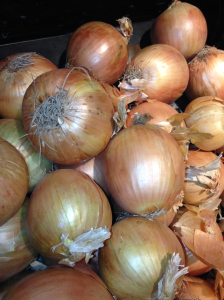
The yellow onion is the most commonly used variety in American cuisine. When you see a recipe that calls for onion, yellow onion is most likely what you need. Thin-skinned and mild, yellow onions are great for all around use, and are the onions I use more often than the others, by far.
Sweet Onions
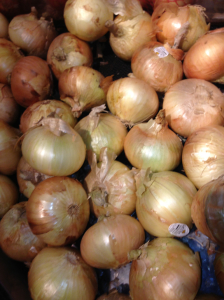
Sweet onions often look like the common yellow onion mentioned above, but are usually less round and more squat and oval shaped. They contain less sulfur than yellow onions and therefore taste much sweeter. There are several well known varieties of sweet onions, including Walla Walla, Vidalia, Maui, Bermuda.
White Onions
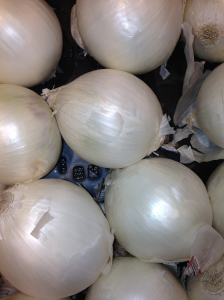
Delicious when lightly sauteed, white onions are the go-to onion when cooking Mexican and Latin American cuisine. Next time you whip up fajitas use a white onion along with your peppers.
Red Onions
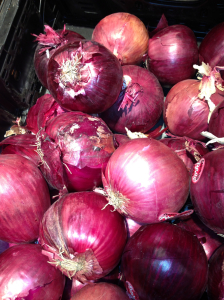
Sharp-flavored and colorful, red onions are often used raw as additions to chili, salads, or any dish that could use a pop (or rather a punch in the face) of pungent flavor. I rarely use red onions as I don’t care for my onions raw, but if you do then this is the onion for you!
No More Tears
One of the reasons many people dislike working with onions are the tears and stinging eyes that come with chopping them. There are dozens of tips (some more effective than others) on the internet about how to solve this problem, and some are downright crazy (chopping onions under running water? Yeah that sounds easy). My favorite trick if you have this problem is to put your onion in the freezer for 10-15 minutes prior to chopping. Don’t leave it in too long or it will be too hard to cut! A nice sharp knife will help as well, as you’ll do less shredding on the onion and therefore reduce the amount of irritants that make it to your eyes.
Cooking with Onions
How to caramelize onions – My method for perfectly rich and sweet caramelized onions.
Beer battered onion rings – My first attempt at onion rings at home turned out pretty darn good!
French onion soup – Not my recipe, but a staple for onion lovers.
Swiss onion tart
A Word About Knives
If there is one kitchen tool that can vastly improve your time spent in the kitchen, it’s a good quality knife. No other tool is used more often on a regular basis, and having a poor quality knife can do a lot to turn a person off to cooking at home (not to mention they can be a safety hazard). While good knives aren’t cheap, they will last you a long time if properly cared for. Save up for a good knife, or perhaps now would be a good time to write Santa a letter letting him know how good you’ve been all year!
What to Look For in a Good Kitchen Knife
Knife preference is subjective, and different people have different preferences in types and brands of knife. However, there are a few qualities in a knife that I think are non-negotiable:
- High quality steel
- Solid handle construction
- Well balanced and good weight
There are many excellent quality brands widely available in the United States; J.A. Henckels and WÜSTHOF are two of the most common. Both are German companies and their knives are very well made. Though not cheap, the investment will start paying off immediately over a cheap knife. My personal favorite knife is the WÜSTHOF Classic Series Cook’s Knife. I most often use the 6-inch version, and I use it for almost every cutting task in my kitchen. For bigger jobs I have an 8-inch Henckels Santoku knife, but I seldom use it.
Wusthof Classic 6-Inch Cook’s Knife on Amazon
Regardless of the brand you choose, you should avoid any knife that:
- “Never needs sharpening.” These are never top-quality knives, and usually have a blade that is somewhat serrated.
- Is sold on TV in the middle of the night. Again, these are never top-quality blades, no matter how many rusty pipes and tomatoes it looks like the knife can cut through.
Connect with The Kitchen Counter Podcast!
Leave me voice mail feedback at: 971-208-5493
Facebook: https://www.facebook.com/kitchencounterpodcast
Twitter: @TKCpodcast
Email:
fe******@ki*******************.com
If you liked what you heard, please consider subscribing in iTunes. You can also help out the show by leaving a positive review in the iTunes store (you know you want to)!
*Source: http://en.wikipedia.org/wiki/Onion

